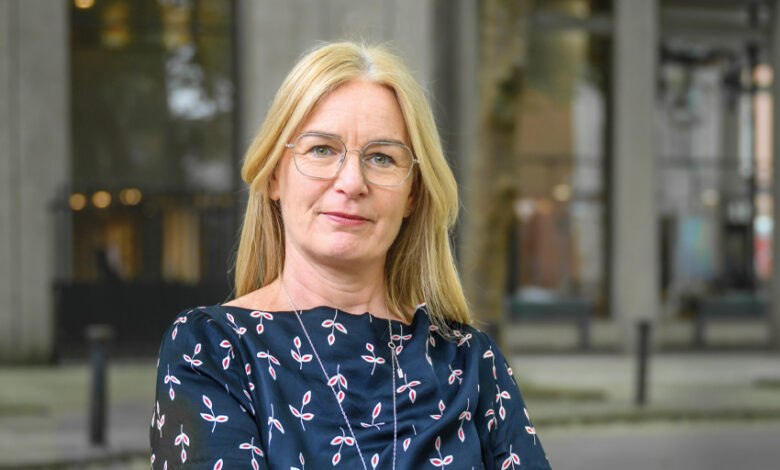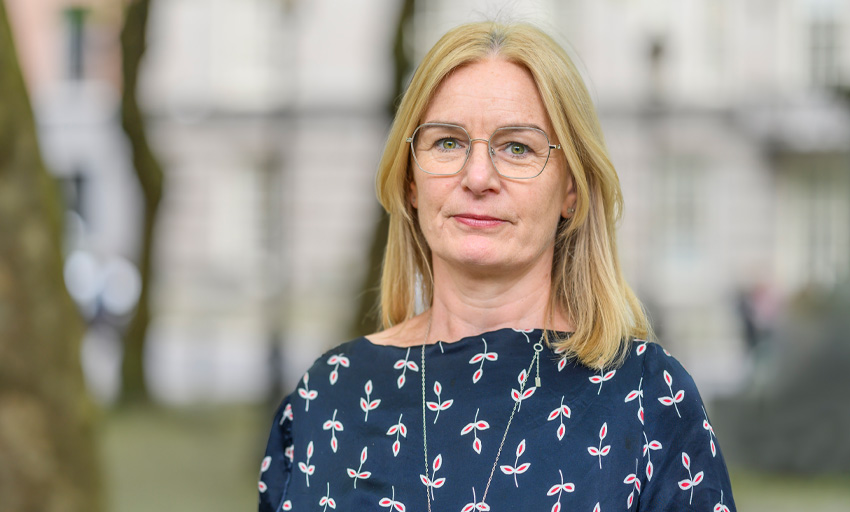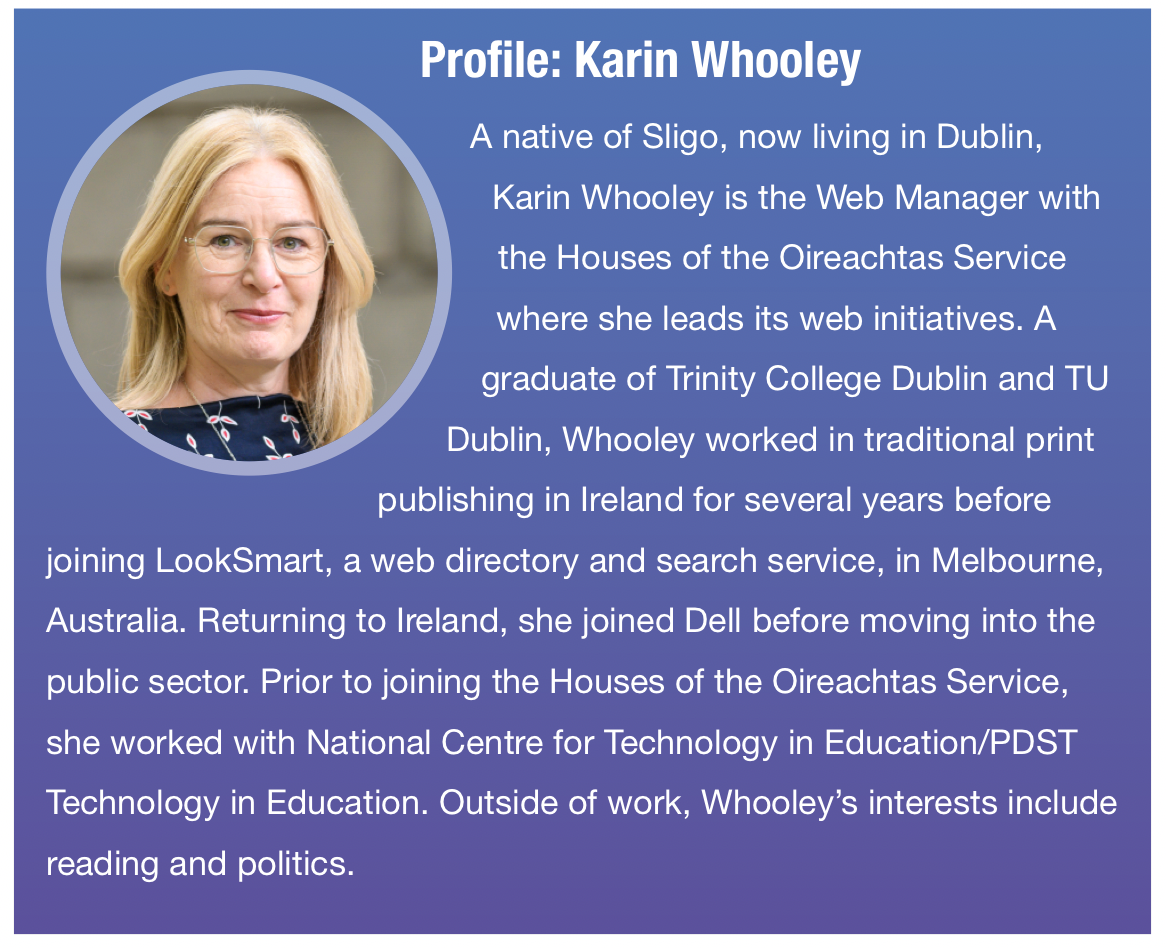Oireachtas.ie: Helping communicate the work of parliament

Karin Whooley, web manager with the Houses of the Oireachtas Service, sits down with Ciarán Galway to discuss Oireachtas.ie – the official website of the national parliament – its role communicating the work of parliament, and its contribution to the Service’s wider Digital Transformation Programme.
Characterising herself as being content orientated, Whooley joined the Houses of the Oireachtas Service in late 2014 to work on the Banking Inquiry website. Having assumed the web manager role within the communications unit, she was initially at the forefront of the digital transformation, tasked with making Oireachtas.ie a more useable website.
“When I started with the Houses of the Oireachtas Service, the goal was to deliver a root and branch transformation of the website. I was keen to see if we could be more efficient by plugging into other systems that exist across the Oireachtas. For example, we now have an API (application programming interface) that pulls in the Debates Office’s data and styles it, on-the-fly, with no manual intervention by us,” she explains.
Taking approximately two years to complete the project, Oireachtas.ie now has four automatic pipelines:
- bills and acts;
- debates;
- Gaeilge translation; and
- scheduling information.
Evolving role
Since the implementation of the Oireachtas.ie project, the web manager role has evolved. “I now operate at a more strategic level. This means I focus on ways to consume content and data from digital projects being implemented through the Service’s Digital Transformation Programme.
“For example, there is real-time data due to come onstream later in 2023 as part of digital signage on campus. I will be working closely with the ICT unit for a way to display that data on Oireachtas.ie so that the website schedule becomes a dynamic schedule rather than a static one. Everything we do is oriented towards delivering a digital parliament and ensuring that Oireachtas.ie does its utmost to showcase an open and engaged parliament.”
Meanwhile, Whooley’s small team is focused on the day-to-day content, design, and development associated with publishing the work of the Oireachtas. They create content for public engagement events, centenaries, special addresses; they manage incoming public queries; they manage the daily publication of reports, opening statements, press releases and corporate documents; and they manage livestreaming, one of the most popular areas of the website.
“Oireachtas.ie does its utmost to showcase an open and engaged parliament.”
Karin Whooley, Web Manager, Houses of the Oireachtas Service
Audience
When the Oireachtas.ie project was initiated in 2016, a significant volume of research was undertaken. In 2023, some of this research was repeated. Despite the time lapse, 95 per cent of respondents indicated that they were happy with the visual design of Oireachtas.ie, while 69 per cent of users indicated they were very or extremely satisfied with the content on the website.
However, Whooley accepts that a minority of users can struggle to always find what they are looking for and that “we still have work to do”. Oireachtas.ie stakeholders, which include Oireachtas members, civil servants, and journalists, have different needs regarding content. With such a diverse audience, the web manager acknowledges that it can be “difficult to meet every need, every time”.
“We are operating in a world where some stakeholders may only be interested in one thing. For instance, a newly published bill or how a particular TD might have voted.
“Oireachtas.ie is so large—it contains more than one million URLs—that it can be tough to prioritise some users’ needs. So, we focus on meeting most users’ needs, most of the time. It is a balancing act, but the recent survey indicates that Oireachtas.ie is delivering for most of its users.”
Web unit
Describing the web unit as a “well-oiled machine” within which each of its five members know their exact role, Whooley notes: “The web section’s role is to act as a conduit, to ensure that the work of other sections is appropriately reflected on Oireachtas.ie, and that it is accurate and current.
“Although we sit within the broader communications unit, our work is completely aligned with the ongoing digital transformation. As new applications and data emerge from across the various offices and sections of parliamentary services, we work with the ICT unit to fully integrate any relevant data into Oireachtas.ie.
“When we receive a request from other sections for new content or a new section on the website, we always approach the build from a strategic perspective. Can we deliver what is requested? What’s the long-term plan for maintenance? Do we need new development work? If so, how much? The ICT unit and the web unit collaborate on all new technical development. We take an agile approach, in terms of project management, working in clearly defined sprints to deliver new features.
“During our latest sprint, which focused on accessibility improvements, we made small visual changes across the website, including a ‘listen’ link at the top of every page so that users can have content read aloud. We also added the schedule for the Oireachtas TV channel to the homepage because it is a major component of the Houses of the Oireachtas Service.”
User-centred design
Defining user-centred design as an iterative process primarily concerned with creating a logical user experience from a linguistic, visual, and functional perspective, Whooley explains how the framework is at the heart of the web unit’s work.
“Having come from a design and content-led background, I focus on user-centred design. In 2016, we conducted a significant amount of research with users. We completed substantial testing with prototype designs, re-wrote our content in plain English, and developed a web style guide to ensure consistency across the site. This approach ties in with the wider Oireachtas strategy to deliver an open and engaged parliament.”
Applying user-centred design principles, therefore, is essential to the work of the Oireachtas.ie team. Much of the work of the Oireachtas is complicated and so they test with real users, including people in government departments and within the Oireachtas.
“We generally test new functionality by asking a user to do tasks in a prototype,” Whooley remarks, elaborating: “For example, can users find a specific deputy’s most recent contributions in the Dáil? If this is a struggle, we must identify that challenge, interrogate it, and re-test the revised design. It is about iterating design to improve it.”

Video-on-demand
Discussing the next major project for Oireachtas.ie, the web manager has set her sights on implementing video-on-demand technology. “While previously we could not implement video-on-demand, it is now firmly among the web section’s ambitions. This is sophisticated in that it is intended to align video with debates so that it can be accessed immediately. The objective is to become more akin to a YouTube streaming experience, making video as accessible and searchable as the transcript of the same debate or committee meeting,” she says.
This is a challenge given the significant volume of video produced in the Oireachtas, however, Whooley is determined to invest in the opportunity, collaborating with the ICT and broadcasting sections, to determine what is possible. While this will incorporate video from 2016 until present, it could also include the older archive dating back to 1990 which is currently being digitised by the broadcasting section.
“The web section’s role is to act as conduit to ensure that the work of other sections is adequately reflected on Oireachtas.ie, and that it is accurate, current, and visually optimised.”
Ambition
Beyond that, the web unit aims to continue to align with Digital Transformation Programme. “In an organisation like the Houses of the Oireachtas Service, it is detrimental to operate in a silo,” Whooley explains, concluding: “It is imperative that we leverage the opportunities being delivered by the Digital Transformation Programme and that our web publishing processes become as efficient as possible. I am keen to explore how we can deliver improved services to members and to sections that produce important outputs, such as the Library and Research Service and the Parliamentary Budget Office. The website is an important communication tool for those sections of the Oireachtas too.
“We need to continue working on creative ways to present content and find new ways to allow some of our niche content to shine. Oireachtas.ie is like a living thing, it is always growing and changing and we have to grow and change our practices with it.”






